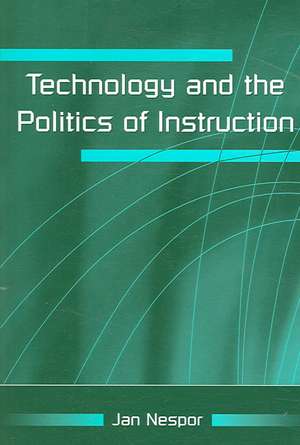Technology and the Politics of Instruction
Autor Jan Nesporen Limba Engleză Paperback – 25 aug 2006
Technology and the Politics of Instruction is distinctive in its multi-level approach and in the breadth of its conceptual frame. Departing from the mainstream research on instructional technology to focus on mundane and widespread forms of CMI—PowerPoint slides, CD-ROMs, self-paced labs, and the like—Nespor views these from multiple standpoints, not just what they mean for professors, but also for administrators and students. The effect is to displace the typical emphasis in CMI research from cutting-edge, high resource artifacts and systems (the importance of which is not questioned) to the politics and organizational processes that shape the uses of such things.
This book is intended primarily for scholars and students in the fields of educational and more broadly organizational change, the politics and sociology of education, curriculum theory, higher education, and educational administration, and will also interest instructional technologists and technology developers.
| Toate formatele și edițiile | Preț | Express |
|---|---|---|
| Paperback (1) | 131.11 lei 3-5 săpt. | +14.60 lei 6-12 zile |
| Taylor & Francis – 25 aug 2006 | 131.11 lei 3-5 săpt. | +14.60 lei 6-12 zile |
| Hardback (1) | 661.75 lei 6-8 săpt. | |
| Taylor & Francis – 25 aug 2006 | 661.75 lei 6-8 săpt. |
Preț: 131.11 lei
Nou
Puncte Express: 197
Preț estimativ în valută:
25.10€ • 25.90$ • 20.81£
25.10€ • 25.90$ • 20.81£
Carte disponibilă
Livrare economică 30 ianuarie-13 februarie
Livrare express 15-21 ianuarie pentru 24.59 lei
Preluare comenzi: 021 569.72.76
Specificații
ISBN-13: 9780805858181
ISBN-10: 0805858180
Pagini: 204
Dimensiuni: 152 x 229 x 11 mm
Greutate: 0.38 kg
Ediția:1
Editura: Taylor & Francis
Colecția Routledge
Locul publicării:Oxford, United Kingdom
ISBN-10: 0805858180
Pagini: 204
Dimensiuni: 152 x 229 x 11 mm
Greutate: 0.38 kg
Ediția:1
Editura: Taylor & Francis
Colecția Routledge
Locul publicării:Oxford, United Kingdom
Public țintă
ProfessionalCuprins
Contents: Preface. Introduction. Part I: Making CMI Visible Within the University. Making CMI Visible as Policy: Instructional Accounting. Seeing Instruction Through the Lens of Finance. Looking Good in Public. Part II: With Sandi Schneider, Seeing Teaching as Work. With Sandi Schneider, Making Disciplinary Objects Visible: Pathology on CD-ROM. With Sandi Schneider, Making Students' Difficulties Visible: The Math Emporium. Making Lectures Visible: Re-Designing in Nutrition. Part III: Making Coursework Visible in the Frame of the Test. Making the Course Visible in Everyday Life. CMI and Organizational Change. Appendix: Data Sources.
Recenzii
“At last! A scholarly, research-based book that refuses to make vacuous claims about the benefits of computer-mediated instruction in university settings.... It is clearly hallmarked for becoming a classic, touchstone text within a range of fields concerned with instruction and new technologies.”
—Michele Knobel
Montclair State University
“This is a wonderful book.... The case study of the growth of computer-mediated instruction at one university is quite comprehensive in describing the many political, practical, sociological, and educational factors that played a role.... The excerpts from administrators, faculty, and students are powerful. [Nespor’s] analysis is very thought provoking.”
—Christian Schunn
University of Pittsburgh
—Michele Knobel
Montclair State University
“This is a wonderful book.... The case study of the growth of computer-mediated instruction at one university is quite comprehensive in describing the many political, practical, sociological, and educational factors that played a role.... The excerpts from administrators, faculty, and students are powerful. [Nespor’s] analysis is very thought provoking.”
—Christian Schunn
University of Pittsburgh
Descriere
This study of computer-mediated instruction (CMI) in a U.S. research university – the site of nationally known innovations in this area – ties together a range of issues usually separated in discussions of instructional technology and examines soften slighted topics, such as the articulations of local and national practices. It questions the common vocabulary for making sense of CMI and contributes to educational change theory by showing how CMI has unfolded both from the top-down and the bottom-up.








